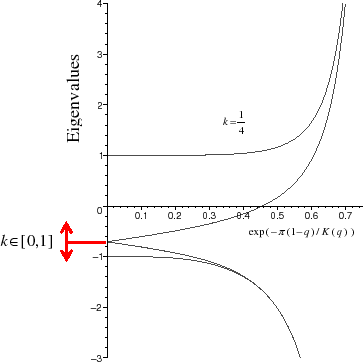|
|
|
[Contents] | [Index] |
Collaborator: J. Dorignac, W. Dreyer, M. Herrmann, J. Sprekels
Cooperation with: A. Mielke, J. Giannoulis (Universität Stuttgart)
Supported by: DFG: Priority Program ``Analysis, Modellbildung und Simulation von Mehrskalenproblemen'' (Analysis, modeling and simulation of multiscale problems)
Description:
This multi-scale study has the objective to derive the macroscopic laws of thermodynamics from microscopic models. A simple microscopic system is the atomic chain, which consists of N atoms with nonlinear interactions between nearest neighbors. This example looks innocent enough, however, it provides an extremely challenging task, and we are still far from the complete solution.
The dynamics of the chain is described by N > > 1 coupled ordinary differential
equations of second order, which can be used to solve at any time t the
positions
x![]() and the velocities
and the velocities
![]() of the atoms
of the atoms
![]()
![]() {1,.., N} for given initial data. The objective is (i) to
introduce a scaling parameter
{1,.., N} for given initial data. The objective is (i) to
introduce a scaling parameter
![]() = 1/N and (ii) to find admissible
classes of initial data and a corresponding scaling of time and space so that
in the limit
= 1/N and (ii) to find admissible
classes of initial data and a corresponding scaling of time and space so that
in the limit
![]()
![]() 0, the dynamics of the chain can be
described by a few partial differential equations.
0, the dynamics of the chain can be
described by a few partial differential equations.
Currently, the establishment of a macroscopic limit is a most contemporary issue in mathematical physics. During the period of this report, we have obtained many new partial results that exhibit the enormous difficulties of the problem.
The literature studies the scalings (i)
![]() =
= ![]() t,
t,
![]() =
= ![]() (
(![]() + ct),
+ ct),
![]() = (1/
= (1/![]() )x, (ii)
)x, (ii)
![]() =
= ![]() t,
t,
![]() =
= ![]() (
(![]() + ct),
+ ct),
![]() = (1/
= (1/![]() )x, where c is a constant, and considers initial data
with small and smooth amplitudes. Regarding example (i), it is essential that
only cold data are admissible. The resulting macroscopic equations are for (i)
the Korteweg-DeVries equation and for (ii) the nonlinear Schrödinger
equation. We study the hyperbolic scaling, where time, particle index, and
position are scaled in the same manner:
)x, where c is a constant, and considers initial data
with small and smooth amplitudes. Regarding example (i), it is essential that
only cold data are admissible. The resulting macroscopic equations are for (i)
the Korteweg-DeVries equation and for (ii) the nonlinear Schrödinger
equation. We study the hyperbolic scaling, where time, particle index, and
position are scaled in the same manner:
![]() =
= ![]() t,
t,
![]() =
= ![]()
![]() ,
,
![]() =
= ![]() x. There results formally a
4 x 4 system of hyperbolic conservation laws for the variables specific
length r, velocity
x. There results formally a
4 x 4 system of hyperbolic conservation laws for the variables specific
length r, velocity ![]() , wave number k, and specific entropy s:
, wave number k, and specific entropy s:
We could prove that at least for the special case that the atoms of the chain interact by means of a Toda potential, system (1) with (2) is strictly hyperbolic and genuinely nonlinear. The figure shows the four eigenvalues of the system. Stability results for traveling wave solutions are currently only available for small amplitudes. However, we have found hints that there is an intimate relation between the stability of traveling waves and the hyperbolicity of the macroscopic system, see [1, 2] for details.
Relying on these considerations, the justification problem could be solved in the high temperature limit, i.e. for hard sphere interactions. Assuming smooth solutions of (1) and (2), a rigorous proof of the macroscopic limit could be found, see [3].

References:
|
|
|
[Contents] | [Index] |